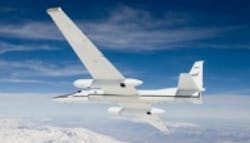NASA’s ER-2 high-altitude aircraft recently completed its fall 2013 series of flights for its Hyperspectral Infrared Imager (HyspIRI) campaign, for which the aircraft captured a unique set of reflected wavelengths to learn more about Earth’s ecosystems.
Two multispectral scanners are mounted in the ER-2 to collect early datasets for the future HyspIRI satellite mission. When launched into low orbit, this satellite mission will study the world’s ecosystems and provide information on natural disasters. The first scanner, the Airborne Visible / Infrared Imaging Spectrometer, or AVIRIS, was developed by NASA’s Jet Propulsion Laboratory (JPL). AVIRIS uses scanning optics and four spectrometers to image a 614 pixel swath simultaneously in 224 contiguous spectral bands. Its four spectrometers, with wavelength, number of bands, and bandwidth, are as follows:
- Spectrometer 1 (0.41 µm – 0.70 µm, 31, 9.4 µm)
- Spectrometer 2 (0.68 µm – 1.27 µm, 63, 9.4 µm)
- Spectrometer 3 (1.25 µm – 1.86 µm, 63, 9.7 µm)
- Spectrometer 4 (1.84 µm – 2.45 µm, 63, 9.7 µm)
In addition, the AVIRIS instrument has a data rate of 17 MB/s, a total scan angle of 30°, and a spatial resolution of 66 ft.
The other instrument, the MODIS airborne simulator (MAS), was developed jointly by the JPL, NASA Ames Research Center, and the Earth Resources Observation and Science Center. MAS is a modified Daedalus multispectral scanner configured to replicate the capabilities of the Moderate-Resolution Imaging Spectroradiometer (MODIS), an instrument to be orbited on a future Earth observing system platform. It is designed for the measurement of biological and physical processes and atmospheric temperature, and it records 50 12-bit channels of multispectral data. Its spectral range starts with Spectral Channel 1 (0.4451 µm - 0.4848 µm) and goes all the way to Spectral Channel 50 (14.051 µm -14.428 µm).
MAS features a ground resolution of 50 meters (163 feet), a swath width of 22.9 miles/19 nmi, a total field of view of 85.92°, and a scan rate of 6.25 scans/second.
AVRIS and MAS together are collecting data under cloud-free daylight conditions during the spring, summer, and fall of 2013 and 2014 over six areas of California from San Francisco to near the Mexican border. The research is being conducted in order learn about Earth’s ecosystems, and how they function and vary from season to season.
View the NASA press release.
Also check out:
NASA's Aqua spacecraft captures images of Super Typhoon Haiyan
Cassini spacecraft image shows Earth, Saturn, Venus, and Mars all at once
Image analysis algorithm will help NASA's Curiosity Rover analyze Mars soil
Share your vision-related news by contacting James Carroll, Senior Web Editor, Vision Systems Design
To receive news like this in your inbox, click here.
Join our LinkedIn group | Like us on Facebook | Follow us on Twitter | Check us out on Google +
About the Author

James Carroll
Former VSD Editor James Carroll joined the team 2013. Carroll covered machine vision and imaging from numerous angles, including application stories, industry news, market updates, and new products. In addition to writing and editing articles, Carroll managed the Innovators Awards program and webcasts.
